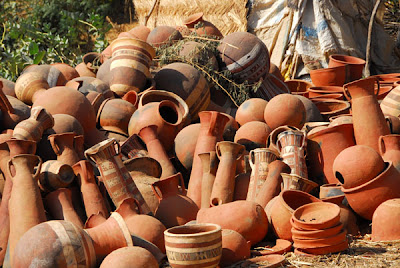[dropcap custom_class=”normal”]Oha soup is a delicacy from South Eastern Nigeria. It is similar to the bitterleaf soup but cooked with Ora leaves instead. This soup is special because the ora leaves used in preparing this soup recipe are seasonal unlike bitterleaf which can be found all year round. [/dropcap]Continue reading
Spotlight Wednesday | Dele Jegede
[dropcap custom_class=”normal”]Dele Jegede is a highly respected and famous Nigerian cartoonist, Painter and Art historian. Professor Dele Jegede is a renowned name in the art industry whose work has made a great impact in the industry. [/dropcap]Continue reading
Some Ghanaian Customs And Etiquette
[dropcap custom_class=”normal”] Here are some interesting facts about Ghanaian customs are etiquette; [/dropcap]
Meet Olawunmi Banjo "The Artist"
[dropcap custom_class=”normal”]Olawunmi Banjo is one of the premium realists with well detailed finishing. She attended the Pan African University, Lagos, Nigeria where she studied Entrepreneurship. Olawunmi is a self developed Artist who loved drawing and painting as a kid, this made her develop a strong passion for her career. Her work captures the ideology that portrays deep and everyday social realities that confronts most societies. [/dropcap]Continue reading
Spotlight Wednesday | Peju Alatise
[dropcap custom_class=”normal”]Peju Alatise is definitely not your everyday conventional artist. Interestingly enough, she has an educational background in architecture and is also a writer. A recurring theme in her work is the significance and power of womanhood. Alatise’s work borders on the theme of women, especially capturing the joys and pains of modern African womanhood. [/dropcap]Continue reading
The Making Of African Clay-Pot
Pottery has a long history in Africa and is one of the oldest arts. Pots are usually made by women. Though cheap and functional, African pots combine utility with great beauty. The procedure for making pots vary within the different communities that span the continent. The process of pottery making in Africa begins with the mining and preparation of the clay and mixing it with water.
Women Mining Clay
Women mining clay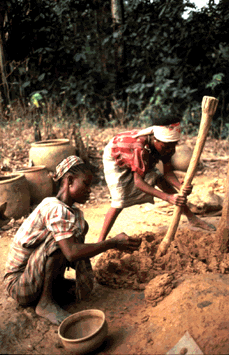
Photos by Prof. Christopher Roy
Clay Preparation
Temper or inert matter is then added to the clay mixture so as to reduce plasticity and to decrease shrinkage of pottery by replacing clay molecules, which contain water that shrink during drying and firing.
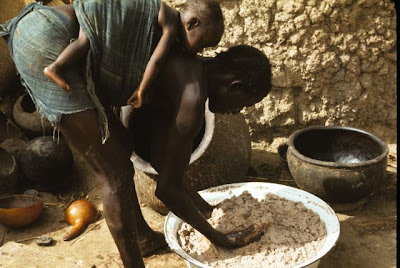
Temper includes finely chopped straw, dried animal dung pounded into a powder, and the chaff left when rice or millet is winnowed to prepare it for cooking, sand, river pebbles, shards of old pottery which have been reduced to a find powder. Tempers are kneaded into the fresh clay in amounts that vary. Generally, the result is a clay body with thirty to fifty percent temper material.
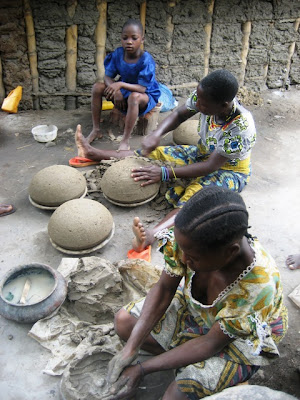

Starting with a mass of clay, most potters work by punching a hole in the center, and pulling the clay apart to give a vessel shape. Some flatten a clay shape over a convex mold and build up a vessel with coils. The potter’s wheel is uncommon in Africa. When they are ready for firing, a few large pots and many small ones are stacked together. Then they are wood fired for about three hours at relatively low temperatures. Some communities use pits and kilns.
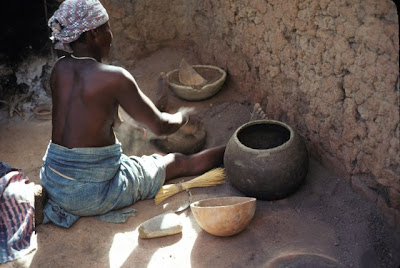


Pre-firing decoration is generally permanent and will survive handling and extensive use of the pot. In contrast, post-firing decoration, such as painting or colored washes, never becomes an integral part of the pot and will eventually wear off the surface.
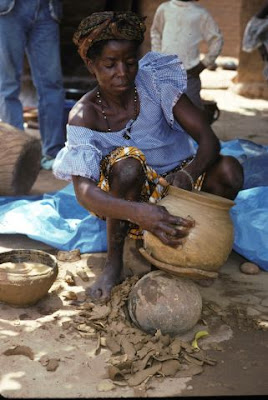
Pre-firing decoration is applied at different stages in the drying process, after the completion of the basic shape of the pot and before the firing. Simple decorations include ones incised into the damp clay with a sharp blade or comb-like tool, impressed with a stamp made for example from split seed pods or shells, or rolled with a roulette made from a dried corn cob from which the kernels have been removed. Pre-firing also helps to drive the last molecules of absorbed water between the clay particles.
Here a potter of the Konate family in the village of Ouri in Burkina Faso prepares to fire large jars that will be used for brewing millet beer.

To pre-fire larger pots, they are turned rim downward on three large stones which keep them off the ground. A small fire is built beneath each pot to complete the drying process. When the pots are sufficiently dry, they are stacked with others for the final firing. The final firing must be begun before the pots have cooled from the pre-firing. If pottery is allowed to cool after the pre-firing, it will re-absorb moisture from the atmosphere and will crack during the final firing. Pre- firing is usually not necessary in the dry savanna where the lack of humidity permits more complete drying of the pottery before firing.
FIRING IN A KILN
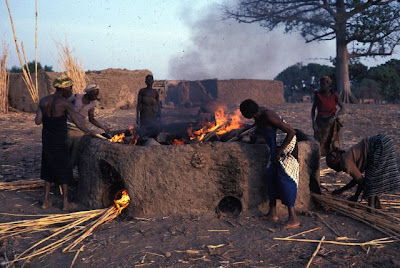
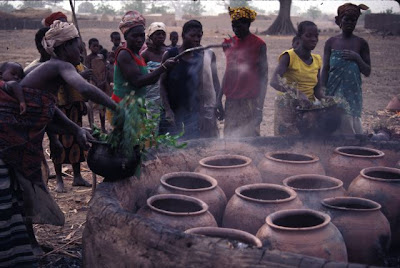
The kiln consists of a low, circular, mud brick wall, with pierced small holes on the base of the which provides air for the firing. Some kilns also have one or more larger holes that permit the addition of fuel during the course of the firing.
A thick layer of fuel is laid over the bottom of the kiln. Then, the dry pottery, interspersed with additional fuel, is piled on top which is then covered with large pieces of broken pottery that helps retain some heat and protect the pottery from direct contact with cool air. The kiln is lit from the bottom.
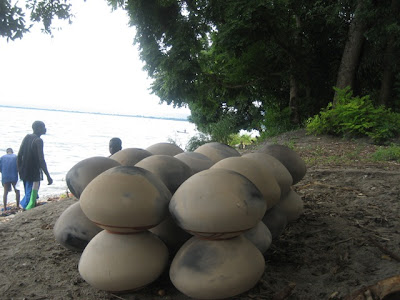
The duration of African firings is very short when compared to the technically complex and lengthy firings of European, American, and Oriental potters.

Once pottery has been fired its basic shape cannot be altered.
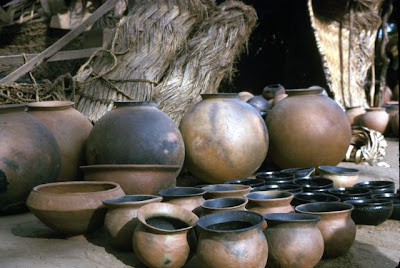



Source: saharanvibe.blogspot.com
Amazing South African Street Art by Lethabo-Thabo Royds
Spotlight Wednesday | Ablade Glover
[dropcap custom_class=”normal”] Ablade Glover has had the benefit of training in countries such as Ghana, Britain and the United States. In the course of this, he has garnered a number of distinctions, showing his importance as an artist and enthusiastic educator both nationally and internationally. [/dropcap]
Peniel Enchill | The Ghanian Illustrator
[dropcap custom_class=”normal”] Ok so I couldn’t help but write about this talented young lady. I actually don’t know her personally but I follow her on Instagram and I also see her work flying all around my social networks, so yes she caught my attention (yes, I’m that bothered LOL). You see I like to dig deep to meet the talent behind any creative work, it inspires me. Her full name is Peniel Ewurama Enchill, born in Ghana and was raised in England. An African talent doing great things. Check out some of her portfolio.. I sure can’t wait to do an Exclusive Interview with her… [/dropcap]
Continue reading
Song of Abidjan: Côte d'Ivoire's National Anthem Lyrics
[dropcap custom_class=”normal”]Song of Abidjan is Côte d’Ivoire’s national anthem. it was adopted at the country’s independence in 1960. The anthem is strongly influenced by religion and tinged with patriotism. The lyrics are from ministers Mathieu Vangah Ekraand Joachim Bony.[/dropcap]Continue reading


